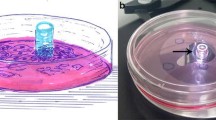We analyzed more than 40 cytotrophoblast cultures derived from cell islets that grew from trypsinized tissue fragments of placental microvilli. Phenotypic variability of trophoblasts was demonstrated. Changes in trophoblast morphology from epithelium-like or oval cells to bipolar and spindle-shaped or twisted and then to mesenchymal-like cells as well as intensive expression of cytokeratin-7 and vimentin attested to epithelial-mesenchymal transition of trophoblasts during in vitro culturing. Analysis of the expression of specific markers in long-term trophoblast culture (≥7 passages) revealed the possibility of culture contamination with other non-trophoblast cells including fibroblasts. High risk of trophoblast culture contamination with rapidly growing cells necessitates regular control of the cultures used in fundamental studies. Our experiments confirmed the possibility of long-term culturing of cells maintaining trophoblast properties. The identity and purity of 4 trophoblast cultures free from contamination and retaining the properties of pure culture during long-term (>10 passages) culturing in vitro were confirmed.
Similar content being viewed by others
References
Kolokol’tsova TD, Saburina NN, Poltavtseva PA, Sukhikh GT. Isolation and culturing of trophoblasts from human terminal placenta. Bull. Exp. Biol. Med. 2014;158(4):532-536.
Aboagye-Mathiesen G, Laugesen J, Zdravkovic M, Ebbesen P. Isolation and characterization of human placental trophoblast subpopulations from first-trimester chorionic villi. Clin. Diagn. Lab. Immunol. 1996;3(1):14-22.
Battula VL, Evans KW, Hollier BG, Shi Y, Marini FC, Ayyanan A, Wang RY, Brisken C, Guerra R, Andreeff M, Mani SA. Epithelial-mesenchymal transition-derived cells exhibit multilineage differentiation potential similar to mesenchymal stem cells. Stem Cells. 2010;28(8):1435-1445.
Bellego F, Vaillancourt C, Lafond J. Isolation and culture of term human cytotrophoblast cells and in vitro methods for studying human cytotrophoblast cells’ calcium uptake. Human embryogenesis. Methods and protocols. Lafond J, Vaillancourt C, eds. London; New York, 2009. P. 73-87.
Bischof P, Irminger-Finger I. The human cytotrophoblastic cell, a mononuclear chameleon. Int. J. Biochem. Cell Biol. 2005;37(1):1-16.
Bullen BE, Bloxam DL, Ryder TA, Mobberley MA, Bax CM. Two-sided culture of human placental trophoblast. Morphology, immunocytochemistry and permeability properties. Placenta. 1990;11(5):431-450.
Ezashi T, Telugu BP, Roberts RM. Model systems for studying trophoblast differentiation from human pluripotent stem cells. Cell Tissue Res. 2012;349(3):809-824.
Giakoumopoulos M, Golos TG. Embryonic stem cell-derived trophoblast differentiation: a comparative review of the biology, function, and signaling mechanisms. J. Endocrinol. 2013;216(3):R33-R45.
Li CD, Zhang WY, Li HL, Jiang XX, Zhang Y, Tang PH, Mao N. Mesenchymal stem cells derived from human placenta suppress allogeneic umbilical cord blood lymphocyte proliferation. Cell Res. 2005;15(7):539-547.
Maldonado-Estrada J, Menu E, Roques P, Barré-Sinoussi F, Chaouat G. Evaluation of cytokeratin 7 as an accurate intracellular marker with which to assess the purity of human placental villous trophoblast cells by flow cytometry. J. Immunol. Methods. 2004;286(1-2):21-34.
Orendi K, Kivity V, Sammar M, Grimpel Y, Gonen R, Meiri H, Lubzens E, Huppertz B. Placental and trophoblastic in vitro models to study preventive and therapeutic agents for preeclampsia. Placenta. 2011;32, Suppl):S49-S54.
Pattillo RA, Gey GO. The establishment of a cell line of human hormone-synthesizing trophoblastic cells in vitro. Cancer Res. 1968;28(7):1231-1236.
Portmann-Lanz CB, Schoeberlein A, Huber A, Sager R, Malek A, Holzgreve W, Surbek DV. Placental mesenchymal stem cells as potential autologous graft for pre- and perinatal neuroregeneration. Am. J. Obstet. Gynecol. 2006;194(3):664-673.
Stenqvist AC, Chen T, Hedlund M, Dimova T, Nagaeva O, Kjellberg L, Innala E, Mincheva-Nilsson L. An efficient optimized method for isolation of villous trophoblast cells from human early pregnancy placenta suitable for functional and molecular studies. Am. J. Reprod. Immunol. 2008;60(1):33-42.
Thordarson G, Folger P, Talamantes F. Development of a placental cell culture for stufying the control of mouse placental lactogen II secretion. Placenta. 1987;8(6):573-585.
Author information
Authors and Affiliations
Corresponding author
Additional information
Translated from Kletochnye Tekhnologii v Biologii i Meditsine, No. 3, pp. 168-174, July, 2017
Rights and permissions
About this article
Cite this article
Kolokol’tsova, T.D., Saburina, I.N., Nanovskaya, T.N. et al. Characteristics of Trophoblasts in Long-Term Culture. Bull Exp Biol Med 164, 259–265 (2017). https://doi.org/10.1007/s10517-017-3969-6
Received:
Published:
Issue Date:
DOI: https://doi.org/10.1007/s10517-017-3969-6




